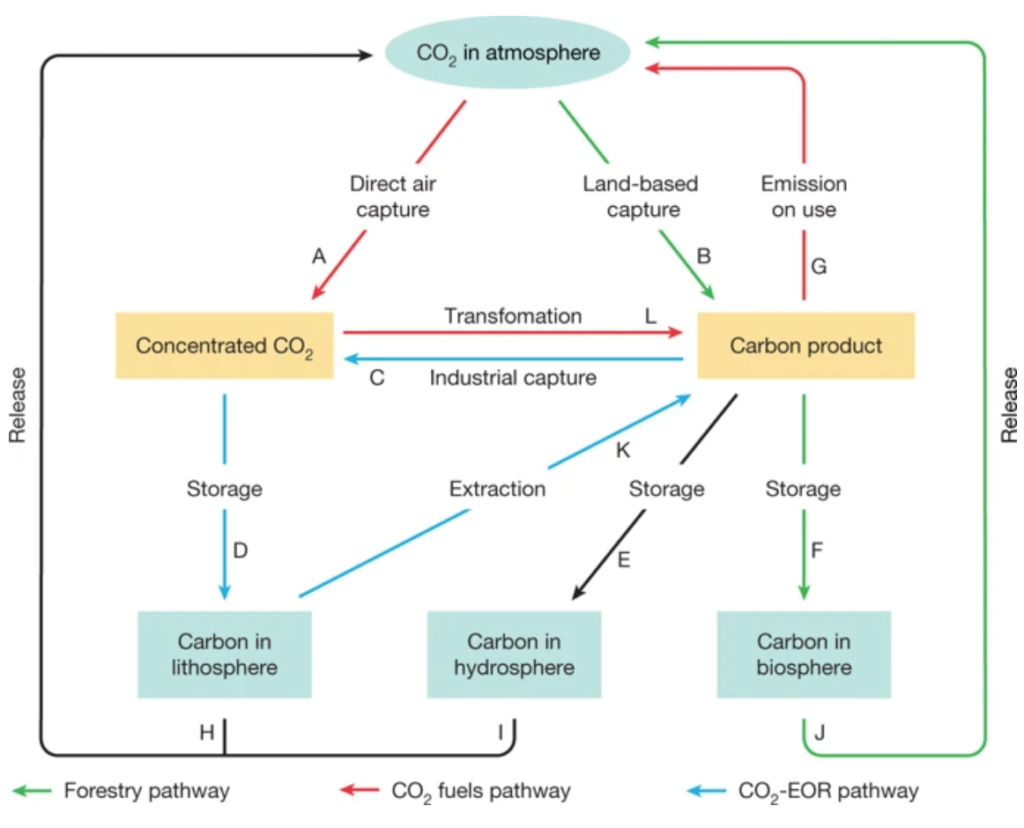Direct air capture for carbon storage (DAACS) is a relatively new carbon sequestration technology that is garnering much attention in business, academic and policy circles. Particularly since the IPCC’s Fifth Assessment Report (AR5) published in 2013, negative emission technologies have been put under the spotlight. Compared to other alternatives, DAACS technologies have a number of advantages, such as being able to address “distributed emissions”, including those from transport, aviation and intensive industrial sectors, which amount to almost 50% of total emissions. However, they have also faced scrutiny as the low concentration of carbon dioxide found in ambient air leads to its capture being extremely energy and cost intensive. This has placed significant doubts on the potential for DAACS to be brought to scale. The high energy intensity and costs they require has pushed numerous researchers and policymakers to recommend focusing on alternative mitigation strategies.
However, a recent paper written by MIT postdoc Sahag Voskian and MIT Professor Alan Hatton, and published in the journal Energy and Environmental Science, outlines a new technology that can capture carbon from ambient air at any concentrations, at low cost and high energy efficiency. This new research adds to other papers that focus on the capture and use of carbon to create valuable products which can therefore offset costs significantly by generating CO2 as a feedstock for cheaper and cleaner production processes compared with using conventional hydrocarbons.
Overall the possibilities for DAACS continue to increase exponentially as interest and investment is aimed in their direction. However, there is still a need for caution and measured optimism, as DAACS is not a universal fix-all solution that allows us to continue emitting greenhouse gasses unabated, but rather a potentially effective tool that must be included in a diversified portfolio of mitigation strategies.
Achieving Negative emissions
There are a variety of negative emissions technology options. Bioenergy with Carbon Capture and Storage (BECCS) and afforestation are the ones that have received most attention to date and are considered the most effective measures for achieving negative emissions, often being included in Integrated Assessment Models. However, these also go hand in hand with criticism due to the perceived un-sustainability of biological options, whereby they generate competition with food, water use, and ecosystems.

DACCS is an additional technological option for achieving negative emissions. However, by using chemical processes to capture and separate carbon dioxide directly from ambient air it overcomes some of the criticism levelled at BECCS and afforestation. Furthermore, the CO2 captured with DACCS can then be separated and put to use to make products or simply injected into geological reservoirs.
The latest DACCS technology, described in the aforementioned Voskian and Hatton paper, is creating a new wave of interest. Hatton and Voskian have developed a DACCS technique that passes air through a stack of charged electrochemical plates. In contrast to most methods, this allows for carbon dioxide removal from low concentration streams of gas, overcoming a problem found in most other methods that require high concentrations. Although there have been other attempts at working with low concentrations, the two researchers argue that the one they have developed is “significantly less energy-intensive and expensive”.
This binary affinity allows capture of carbon dioxide from any concentration, including 400 parts per million, and allows its release into any carrier stream, including 100% CO2.
MIT postdoc Sahag Voskian.
Furthermore, the carbon captured is separated and can then be used for a variety of different purposes. For example: “if the desired end product is pure carbon dioxide to be used in the carbonation of beverages, then a stream of the pure gas can be blown through the plates.”
In this way not only are you eliminating the need for fossil fuels to make a wide range of products that require carbon, but you are also removing greenhouse gas from the air. Most importantly the process is significantly less energy intensive, using about one gigajoule of energy per ton of carbon dioxide captured. In contrast, alternative methods consume between 1 to 10 gigajoules per ton, depending on the inlet carbon dioxide concentration, explains Voskian.

Laurent Drouet, senior researcher at European Institute on Economics and the Environment and research affiliate at Centro Euro-Mediterraneo per i Cambiamenti Climatici (CMCC), and co author of the study “An inter-model assessment of the role of direct air capture in deep mitigation pathways”, comments on the Voskian and Hatton paper by explaining that: “the technology looks interesting, especially the fact that it works at normal temperature, meaning that it does not require heating. The estimated cost is lower than the current estimated range.” In fact, he further elaborates by claiming that, “The cost of DACCS has recently been assessed to be between $600 and $1,000 per tonne of CO2 for the first-of-a-kind plant, with nth-of-a-kind costs potentially of the order of $200 per tonne of CO2 (Keith et al.).”
However, Drouet also advises caution and claims that: “it is too early to tell if the technology will be a game changer but it proves that there is a large potential for improvement in reducing the investment and operation costs of DACCS.” Furthermore, a major worry for researchers is over-reliance on negative emission technologies and how these could influence our approaches to climate change mitigation strategies, with some indicating that an over-reliance on these factors is already affecting integrated model assessments and hence the decisions of policymakers with regards to reducing emissions as soon as possible.
Not a fix-all-solution but a tool in the mitigation repertoire
DACCS has two major roles for decarbonization: it helps to achieve the climate targets, as defined in the Paris agreement, and it lowers decarbonization costs. However, “there are clear risks of planning a long-term mitigation strategy on the assumption that DACCS will be available and can scale up at speed.” In particular, Drouet’s paper indicates that possible issues could be, “the chemical pollutant implications of sorbent manufacture at vast scales, as well as a requirement to use around a quarter of global energy demand to provide power and heat for DACCS technologies by the end of the century.”
This highlights serious issues around relying entirely on DACCS as a panacea to our CO2 problem. Therefore, it is important that DACCS are included in a diversified mitigation portfolio, together with other carbon dioxide removal strategies, demand-side and lifestyle measures.
Drouet concludes that, although “DACCS technologies should receive investment in research development and demonstration (RD&D), so that it eventually becomes a competitive technology for decarbonization. Without any support, the price of DACCS will remain high and DACCS won’t scale up, which is one of the main requirements for its effectiveness.” However, he is careful to stress that, “DACCS is certainly not an alternative to reducing emissions. A portfolio of mitigation measures should be considered (mitigations of emissions, reduction of the energy demand, other negative emissions technologies). Relying too much on DACCS will allow for a large climate target overshoot, with the risk of suffering from some climate impacts, exceeding tipping points or not succeeding in scaling up the technology.”






